The early history of firefighting in the United States is an interesting story of crude equipment, political infighting, and fierce rivalries. In the 1700’s various volunteer firefighting companies, usually nothing more than glorified “bucket brigades,” ruled the day in most cities. In the 1730’s the first fire insurance companies came into existence and the buildings they insured would be branded with a noticeable “fire mark.” The marks were important (especially later on) as they signified the building was insured and funds were available to reimburse firefighting brigades. If a building was unmarked the volunteer firefighting units would often look the other way.
Initially the insurance companies had their own firefighting companies to protect the buildings they insured, but volunteer units soon came to dominate the industry. The insurance companies would then pay the first fire volunteer company that arrived to put out the fire on one of its insured properties, and this led to intense competition – often resulting to fistfights and mass brawls – among the firefighting brigades. Many wealthy men founded and took an active part in the volunteer firefighting companies. Membership was a sense of civic pride.
The first organized volunteer firefighting company in New Castle, Pennsylvania, was established in September 1836. It was made up of a host of prominent local businessmen headed by President Joseph G. Boyd and led in action by Captain William Dickson. It wasn’t until 1848 that this group purchased its first fire engine, an old hand-cranked apparatus that was pulled by the firefighters themselves. A rival unit known as the Eagle Fire Company was organized in 1851 and led by President B. B. Pickett.
The city council provided limited financial backing to both of these companies to help them protect the downtown area of New Castle. A story in the New Castle News of Friday, July 28, 1922, reflects on the situation and had this to say, “Great rivalry existed between the two companies, and more than once the streams of water played upon the opposing companies instead of upon the fire.”
Additional firefighting units were soon formed to include the Relief Fire Company in 1858 and the New Eagle Fire Company in 1871. It was during the 1870’s that the old ways of the competing companies slowly gave way and a new era of cooperative firefighting techniques was ushered in. In 1872 the city council hired Captain John Young as the first official Fire Chief to oversee the firefighting efforts within New Castle. Three years later in 1875, when the city had only three salaried firefighters, the first horses were purchased by the city council for use by the firefighting units.
Various other volunteer companies were formed in the coming years to include such units as the Neshannock Hose Company, Vigilant Hook & Ladder Company, Vandevort Fire Company, Niagara Fire Company, Holten Fire Company, George W. Johnson Hose Company, and the W. D. Wallace Hose Company. These names faded out over time as the city took control of all firefighting efforts. The various railroads also had their own fire stations.
In 1881 a Central Fire House was built on East Street next to the old City Hall, where for the first time the Fire Chief oversaw all city-wide firefighting efforts. The most profound advancement, which revolutionized firefighting in New Castle, was the implementation of the modern waterworks system in 1882. Companies could now race their horse-drawn apparatus (and hoses) to a specific site and hook up to water mains supplied by two large reservoirs. In 1891 the first of dozens of Gamewell alarm boxes were installed to help quickly alert the Central Fire House of developing fires.
The fire department continued to evolve at the turn of the century, and especially under the reign of Fire Chief Frank J. Connery beginning in 1901. The well-respected Connery, who joined the volunteer ranks as a firefighter in 1872, went on to serve as Fire Chief from 1901 until retirement at the end of 1924.
By 1905 the city maintained fire stations in the various city wards including on Park Avenue (2nd Ward) in the North Hill area, on Ray Street (4th Ward) and another on Vine Street (3rd Ward) in the Croton area, on Smithfield Street (6th Ward) on the West Side, on Sciota Street (5th Ward) on the South Side, and on Cherry Street (7th Ward) in Mahoningtown.
Most downtown buildings in those days were hardly fireproof and the duties the firemen performed placed them were in constant danger. Sometimes just being at the station was risky as the New Castle Weekly Herald of Wednesday, December 6, 1905, reported, “Fire Chief Connery and six firemen barely escaped asphyxiation at the Central fire station early Sunday morning. They were awakened by the cry of fire and found the lower part of the structure in flames and their sleeping apartments filled with smoke. They city building seems to be hoodooed as this is the second fire the structure has suffered within a week… To be awakened by the cry of fire is not a new thing to the chief and his assistants, but to be awakened by the same cry when the fire is in their own apartments, is an entirely different story… Although all the men were suffering from the effects of the fumes and smoke they had inhaled while sleeping and were weak from the effects, every man worked like a Trojan and deserves credit for the fight they made.”
New horses were periodically added to the force as the New Castle News of Wednesday, January 25, 1911, mentioned, “Fire Chief Connery and Common Councilman Turner of the horse committee of councils spent Monday scouring the countryside for horses to be used in the central fire department in this city, and two horses were purchased. Both of them are six years of age and one is a bay, the other a brown. One horse was purchased from R. C. Shoemaker near Wurtemburg, while the other was purchased from C. Wilkinson on the Pittsburg Road. $537.60 was paid for the team… The horses which have been in service for years on the hose wagon at the central department will be sold.”
It was during that same time that the first motor-drawn engine was put in service in October 1911 at the Central Fire Station. The water-pumping portion of the old “engines” had been motorized for some time (and pulled by horses), but this was the first motor-propelled fire truck. In the coming decade all the stations received motorized fire trucks as the longtime use of horses was completely phased out.
The New Castle News of Saturday, November 25, 1916, had this to say, “Within the past few days one of the horses that had been in the fire service for some years, was retired. It was done so far as service in the fire departments is concerned… Horse-drawn fire fighting apparatus has about seen its last day. With the installation of an auto fire engine in the Seventh ward department another step will have been taken toward complete motorization of the city fire department. The horses at that department which will be replaced by a motor truck may be transferred to one of the few remaining departments where horses are sued or they may be held in reserve… The Seventh ward truck and engine will make five auto fire fighting machines in the city.” The Seventh Ward initiative was soon stalled and it was at least another year before the Mahoningtown station took possession of a modern fire engine.
The active use of Dalmatians or “coach dogs,” long a mainstay of fire stations, was also phased out with the horses. Dalmatians – who are known for their odd affinity for horses – performed valuable service by guarding the horses from possible theft, providing companionship for the horses during quiet times, arousing the horses during an alarm, barking to alert the public to clear the front of the fire house, and running alongside the horses and firemen as they raced to the fire. The canines would still remain popular at fire stations, but mainly as watch dogs and companions for the firemen.
In January 1920 the department also implemented a platoon system, where firefighters manned the stations in round-the-clock shifts. The New Castle News of Friday, July 11, 1919, reported, “Establishment of the two platoon system in the fire department of the city is mandatory and becomes effective January 1, 1920. The law just signed by the governor, states that the force must be divided into two bodies or platoons excepting the chief and assistants. The hours of service may not exceed ten for the men on the day shift and fourteen for those on the night shift.”
It appears by the early summer of 1921 the Smithfield Street location was the last fire station equipped with horses. The New Castle News of Tuesday, May 3, 1921, reported, “The Sixth ward fire department truck which is being remodeled from a horse drawn vehicle to a motor driven apparatus will be ready to deliver to the city some time next week according to the information received… When this piece of apparatus is returned the entire equipment of the fire department will be in service and will be motor driven.”
A new Central Fire Station was opened on Jefferson Street (at the intersection with Grove Street) in August 1928. In early 1935 the New Castle Fire Department, supervised by the Fire Chief and the Assistant Fire Chief, had ten motorized fire engines and eighty-eight paid firefighters. They were augmented by 135 volunteer firefighters and an additional force of two dozen Fire Police members who provided on-scene crowd control, property protection, and other associated duties. The city also began to work in close conjunction with other smaller paid or volunteer fire departments that were established, such as those in Shenango Township (established 1935), Neshannock Township (1940), and the South New Castle Boro (1954).
Some of the famous fires that department fought over the years involved the Old City Building on June 9, 1876, the Park Opera House of March 30, 1890, and original Shenango Valley Hospital of April 8, 1893, the Coliseum-Liberty Theater of March 7, 1926, the old Allen Opera House-Capitol Theater of February 28, 1931, the G. C. Murphy Store of March 31, 1937, the Central Presbyterian Church of March 19, 1949, the North Street School of February 2, 1952, the Fisher Brothers Dry Goods Store of December 22, 1960, the Leslie Hotel of February 4, 1968, and the Fountain Inn of February 24, 1968. The department also fought numerous small fires – and took part in the active investigation with state and federal authorities – during a major arson case on the East Side during 2007-2009.
By the 1950’s a handful of the old firehouses were nearing the end of their useful lives. Ray Street was closed in early 1956 and soon condemned. As a temporary replacement a residential house was acquired on Finch Street in January 1957 and was put in use as a fire station. The firemen from the former Ray Street fire house, after spending the last year at the Central Fire Station, manned the Finch Street property.
A building program was soon initiated and the new station on North Cedar Street in Mahoningtown was opened in October 1958. The stations at Finch Street and Park Avenue were also slated for replacement. The temporary station at Finch Street was demolished after the new station, built right next door, was partially opened in August 1961. The old Park Avenue station was also replaced with a new building that opened in November 1963. That Park Avenue site was initially known as the Harold L. Reynolds Fire Station, named in honor of the late city councilman who did much to support the firefighting efforts in New Castle. A public open house was held at the Park Avenue location on December 5-7, 1963. The Scioto Street station was closed in 1967.
By the mid-1970’s, with increased financial difficulties, the department began downsizing and many of the old fire stations in New Castle were about to be shuttered. The station at Vine Street closed in 1976 and the Smithfield Street station followed suit in 1979. The Central and Cedar Street stations continued to operate around the clock, while the Finch Street and Park Avenue stations were only manned on a part-time basis. The downsizing continued as the Finch Street and Park Avenue stations were both closed for good in 1984. From then on New Castle was served by only the Central Fire Station in the downtown area and the Cedar Street Fire Station in Mahoningtown.
In early 1995 serious discussion was began on whether to upgrade the aging Central Fire Station, or relocate and build a new fire house elsewhere. There was plenty of heated public debate about how to proceed, but eventually city officials set their sights on the vacant Bell Atlantic maintenance garage on Margaret Street.
The New Castle News of Friday, May 24, 1996, reported, “The city reached an agreement this morning to buy the former Bell Atlantic work center on Moravia Street for a new fire station. New Castle Mayor Tim Fulkerson said Gold & Co. of Pittsburgh, representing the utility, has accepted the city’s $200,000 offer for the 14,000 square-foot building.”
Mayor Fulkerson sounded rather frustrated at the process as the same article mentioned, “At last night’s regular meeting, council members and Fulkerson agreed that the deal would be a bargain for the city. “I’m tired of hearing comments from the public, that we’re about to spend a lot of money on a building that we haven’t even seen,” the mayor said. “We have looked at it closely and we know what we’re looking at. I am in the building construction business and(Councilman) Ed Jopek has been in construction for 30 years. We have looked at this building and it is a real bargain.” Jopek agreed. He said he has inspected the premises and is favorably impressed. “I believe that for what we’re getting, it is a steal,” he said.”
The building was renovated in early 1997 and was officially dedicated during a ceremony held on Saturday, July 12, 1997. The old Central Fire Station on Jefferson Street was closed down. In October 1997 it was sold for $45,000 to Gabriel and Marc Cilli, who later renovated the structure into an office building.
As of 2018 the paired-down New Castle Fire Department, with about two dozen paid firefighters and a Fire Chief, operates the main station (Central Fire Station) on Margaret Street in the downtown area and a substation on Cedar Street in Mahoningtown.
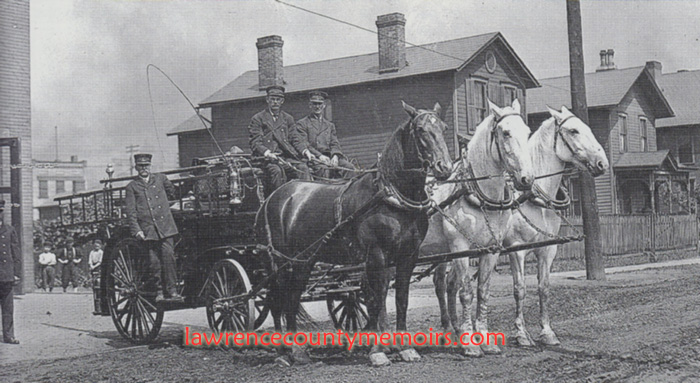 The first organized volunteer fire brigade in New Castle was founded in 1836 and the early firefighters were armed with only buckets. The units became more modernized as time went on and the city council acquired the first horses (such as those above) for firefighting duty in 1875. Just when the actual “New Castle Fire Department” was organized can probably be traced to 1872, when the city council hired Captain John Young as the first official Fire Chief and began hiring the first paid firefighters. (1910) Full Size |
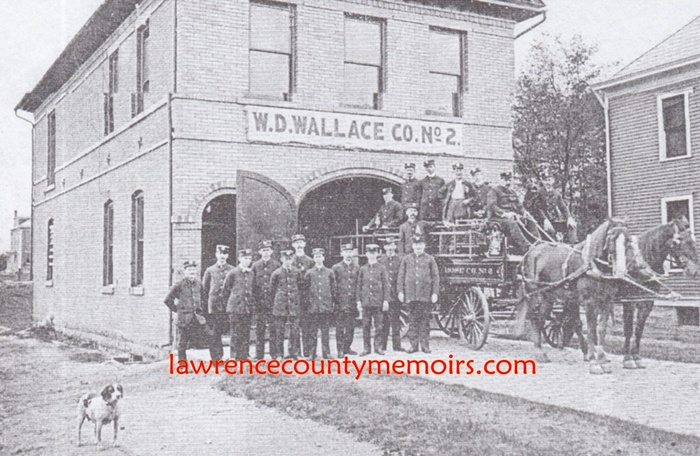 The W. D. Wallace Hose Co. No. 2 was organized in about 1900 by attorney William D. Wallace, who served as the Lawrence County Judge from 1895-1905. It was located on Park Avenue. I believe the horses were purchased from well-known horse dealer Norman Rodgers. (c1905) Full Size |
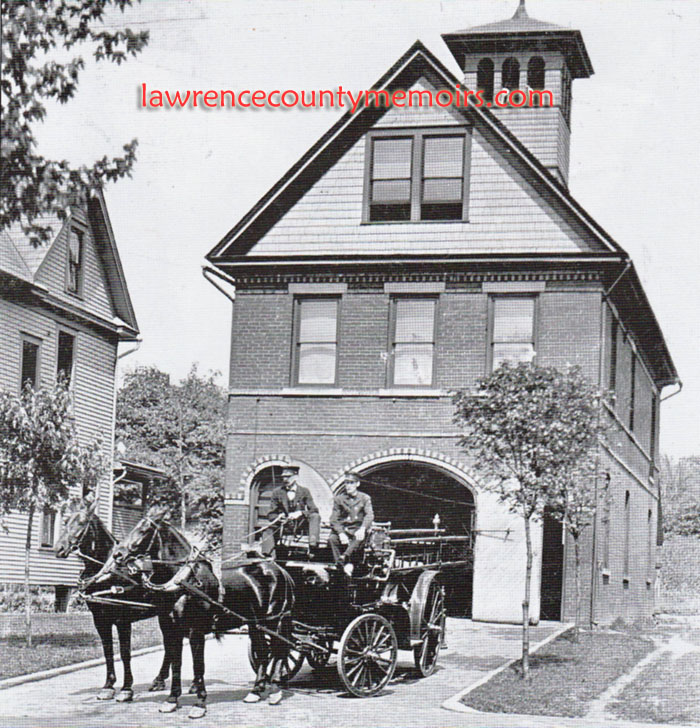 The No. 4 Hose & Chemical Company, housed in the 4th Ward station on Ray Street (near Pearl Street) in Croton. Another fire station, founded in 1902, was located nearby in the 3rd Ward on Vine Street. (c1912) Full Size |
 Another photo of the fire house on Ray Street in the Croton area of New Castle. (c1910) Full Size |
 Some of the motorized fire trucks, the first of which were purchased in 1911, in front of the old Central Fire Station (or Central Engine House) on East Street in downtown New Castle. This building was located directly behind the old City Hall. The building at the extreme left edge, with a facade marked “1900,” is the neighboring Police Station. The Central Fire Station was built in 1881 and replaced with a new Central Fire Station on South Jefferson Street in 1928. (c1920) Full Size |
 |
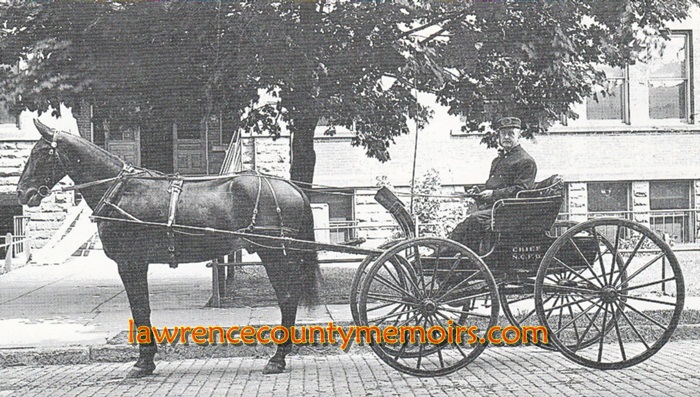 The well-respected Frank J. Connery (shown above), who was born in New York City but came to New Castle as a youngster, served as the Fire Chief for twenty-two years from 1901-1923. It was under his reign that the department began modernizing and commenced using motorized vehicles beginning in 1911. He retired at the end of 1923 after forty-eight years of dedicated service to the New Castle Fire Department. He died in Pittsburgh not long after at the age of seventy-one on March 23, 1924. He was interred in St. Mary’s Cemetery in New Castle. (c1900) Full Size |
 |
 This photo depicts the paid members of the New Castle Fire Department in 1926. The inset photos depict Fire Chief Charles H. Lynn (1875-1932) and former Fire Chief Frank J. Connery. When Connery retired in late 1923 he was succeeded by Lynn. Lynn was a volunteer fireman who became a paid firefighter under Chief Connery back in 1902. Lynn was later overcome by smoke while battling the famous Capitol Theatre (old Opera House) blaze on February 23, 1932. He was bedridden for some time, contracted pneumonia, and passed away two months later. His unfortunate death, though not unexpected at the time due to his condition, was a huge blow to the fire department and the city as a whole. (1926) Full Size |
 The second Central Fire Station was opened on South Jefferson Street (at Grove Street) in the downtown area in August 1928. It was built on property owned by the Race family that was condemned by the city in 1926. This station closed in the summer of 1997 as a new Central Fire Station opened on Margaret Street. This building was sold a few months later. It was renovated and is still in use as the Cilli Central Station, housing a law firm and various other business offices. (c1984) (Don Jenkins photo) Full Size |
 |
 An artist’s rendering of the new Central Fire Station on South Jefferson Street. A mention in the New Castle News of July 11, 1928, reads, “In the new fire station will be the fire engine, aerial ladder truck and the chief’s car, now in the East street station and in addition to the new ladder truck recently ordered.” (1928) Full Size |
 |
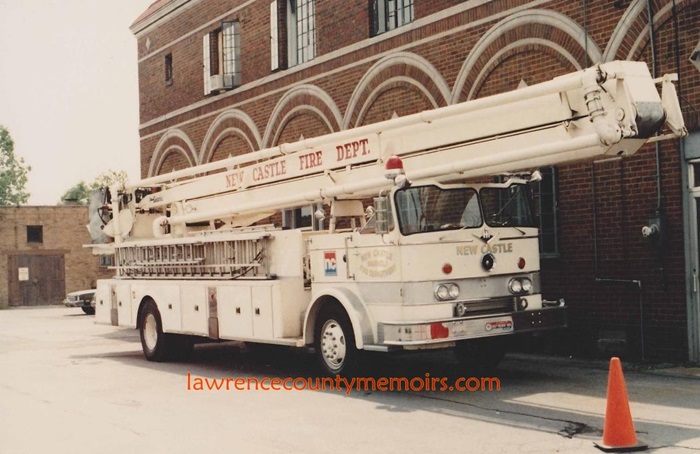 A ladder truck belonging to the Snorkel Co. 1 at the Central Fire Station. (c1985) (Don Jenkins photo) |  A spare fire truck that formerly belonged to the Engine Co. 2. (c1985) (Don Jenkins photo) |
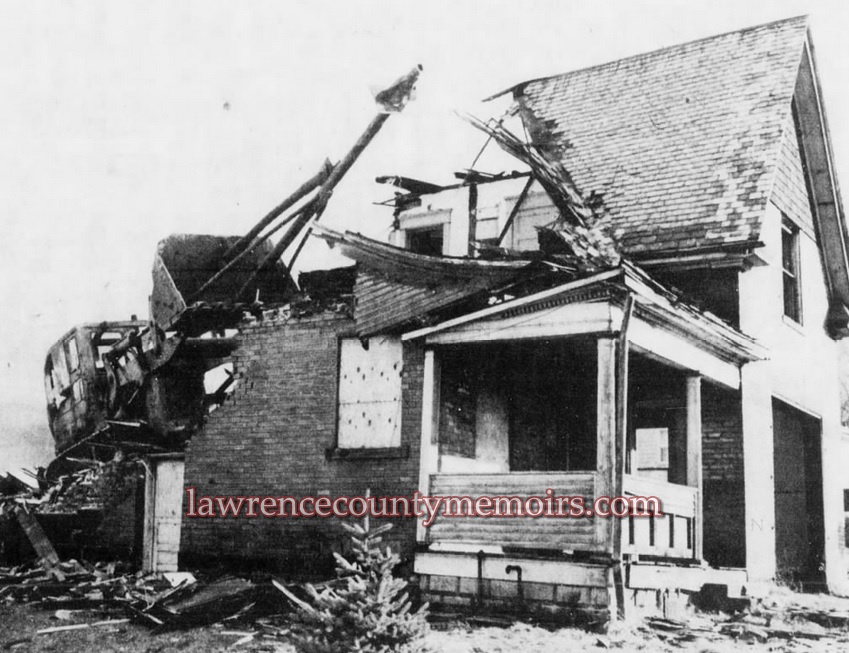 The old fire station on Vine Street was closed in 1976 and is shown here being demolished in December 1977. (1977) |
 The Finch Street fire station soon after it closed in 1984. (1985) |
 The former “second” Central Fire Station on South Jefferson Street, in operation from 1928-1997, is now a commercial building known as the Cilli Central Station. (Oct 2012) Full Size |
 The former Central Fire Station on South Jefferson Street. (Oct 2012) |  The facade of the old Central Fire Station on South Jefferson Street. (Oct 2012) |
 The new – or third – Central Fire Station of the New Castle Fire Department is located on Margaret Street. (Oct 2012) Full Size |












Comments
John Jay Moss #
I am possible moving into the New Wilmington area and i was curious about employment with New Castle Fire. I am currently a lieutenant with 14 yrs of service in the Hookstown Fire dept in beaver county PA. I am also a paramedic. Please Email me back and let me know if you will be hiring in the near future and what the requirements are for employment. Thank you, John Jay Moss
wesley cartwright #
Thought you would like this
Comment